Safety and reliability first: choosing and installing a cast iron sauna stove
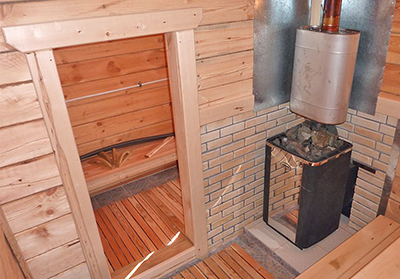
Cast iron is hard but brittle alloy of iron and carbon containing impurities of other chemical elements.
The plasticity and viscosity of this material depend on the amount of carbon and the types of its compounds. Compositions where carbon content less than 2.14%, are called steel. It is the brittleness of cast iron that prevents welding of parts.
Cast iron elements are produced using the casting method.
Parameters of bath stoves made of cast iron with a remote firebox
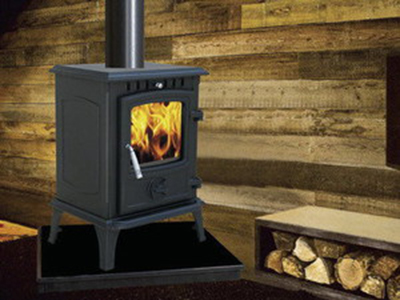
The efficiency of a sauna stove is influenced by the following factors:
- Performance or power – the ability to give off a certain amount of heat per unit of time. The power depends on the volume of metal in the firebox body, the mass of the stones, the design of the heater and the type of fuel.
- Cast iron bath stoves run on wood or peat briquettes. It is not recommended to use coal, it burns at a temperature over 350-400 degrees. Heating cast iron stoves with coal heats the parts to red-hot temperatures and the stoves fail.
The wood fuel material must be dry, preferably deciduous, and be approximately the same length and thickness for uniform combustion and heat transfer.
Important! Raw firewood smokes, does not emit heat, and at the same time, gases form in the stove and chimney harmful deposits of soot and carbon.
- Moving the firebox outside the steam room will make the stove safer to use, will keep the steam room clean from soot, flammable gases and will protect the firewood from getting wet. This solution will not affect the stove's performance, but will allow you to heat the entire bathhouse with one unit.
- The strength of the cast iron depends on the quality, resistance to thermal shock and durability of the unit.
- The cast iron in the furnace parts has a thickness of 10 to 60 mm. The thinner the walls of the structure, the faster the sauna stove will heat up and cool down.
- The presence of a fireplace glass in the firebox door gives the stove an aesthetic appearance. and allows you to visually control the combustion process.
- A closed heater accumulates more heat, than the open one and is better suited to creating the steam effect of a Russian bath.
Criteria for choosing a cast iron stove for a Russian bath
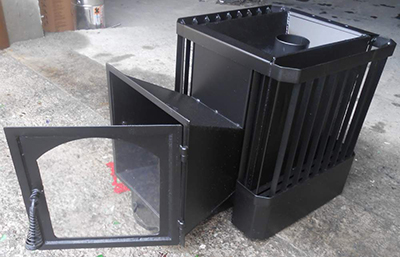
The market offers a variety of models of cast iron sauna stoves, similar in characteristics, but having significant difference in the work process.
To correctly select the appropriate unit, pay attention to the following parameters:
- Correspondence of the steam room area to the furnace capacity. It is not advisable to install a powerful unit in small rooms, otherwise the sauna will be too hot. If the amount of wood burned is reduced, the heater will not have time to warm up to the desired temperature.
- Installing a stove with a firebox door directly in the steam room is justified, if the bathhouse does not have a changing room or other adjacent room.
- The type of heater is selected based on the preferences of the steam effect. A closed heater is suitable for obtaining finely dispersed light water vapor of a Russian bath, while an open heater is for those who appreciate the dry hot effect of a sauna.
- The design includes heat exchanger for connecting the water circuit and removal of the hot tank separately from the fuel unit.
Important! Solid cast iron fireboxes more reliable than national teams. The fewer joints there are, the higher the tightness of the firebox and its safety.
Finishing the firebox with natural stone increases its heat output, gives it a finished look, and protects the unit from temperature changes.
Installation of a structure with a water tank
The location of the stove in the steam room can be corner or wall-mounted, is determined based on the design solution, the order of the rooms, the side of the firebox, and the chimney outlet.
The chimney pipe is being brought out outside the steam room so that it does not hit the supporting structure of the ceiling.
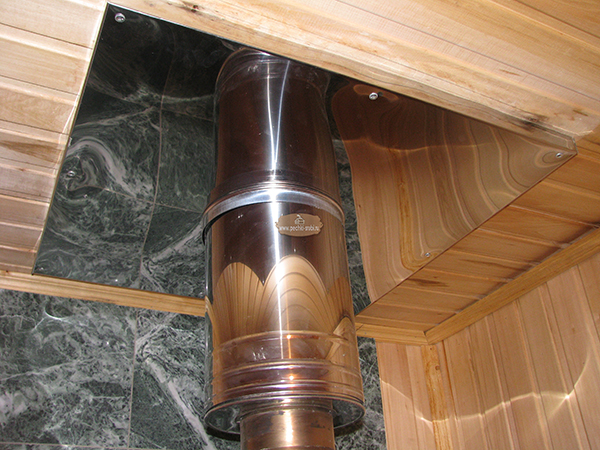
Photo 1. The chimney pipe extends beyond the steam room, the walls are decorated with heat-resistant ceramic tiles.
Before assembling and installing the bath unit, prepare a place for it:
- Depending on the total weight of the furnace structure, the foundation is poured, the joists are reinforced with additional posts, and the transverse floor covering is laid.
- Fireproof shields are installed on the walls and floor under the firebox. The simplest material is stainless steel sheets. At the owner's request, wall panels are decorated with heat-resistant ceramics.
- Provide openings for the chimney outlet and firebox door.
How to install a heat exchanger
The cast iron stove is assembled according to the constructor principle from the bottom up:
- connecting the fuel tank parts with bolts using a ceramic cord, sealant;
- installation of ash pan and grate;
- fixing a flame spreader inside the combustion chamber;
- installation of heat exchanger, outlet of pipes;
- assembly of the heater;
- hanging a water tank;
- connection to the chimney;
- filling the grid with stones.
Important! The door with glass is hung last to avoid damage during installation work.
During assembly, it is necessary to carefully treat with heat-resistant material all joints for their tightness, unless this was provided in advance by the manufacturer.
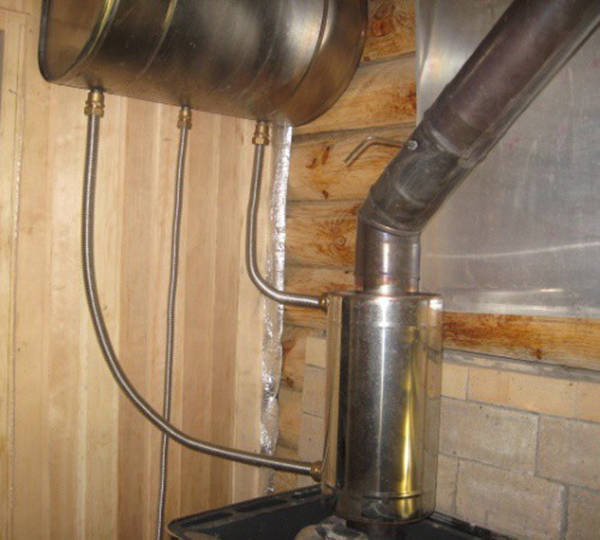
Photo 2. A metal water tank suspended from the wall, the design of which includes a heat exchanger.
The ceiling or wall where the chimney exits is finished refractory material to prevent ignition from the temperature of the chimney.
The remote firebox is insulated from the walls with brickwork or other material, even if the entire stove finishing is not planned.
Useful video
The video provides recommendations on choosing a suitable cast iron sauna stove with a heat exchanger.
The final touch
Finishing the firebox with natural stone or decorative brick is mandatory to achieve the effect of a Russian bath - fine steam and light "good" heat. Without additional work, you can get not a bathhouse, but a sauna.
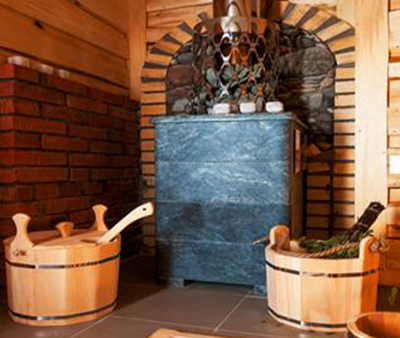
Exposed metal parts of the fuel apparatus emit aggressive heat, burn oxygen in a steam room, are dangerous. Unfinished stoves create pronounced convection and produce heavy water vapor.
Chimneys also transmit heat and need to be enclosed. In addition, brick finish The pipes will make the stove more fireproof.
The temperature of combustible gases in the chimney pipe will be significantly reduced due to the masonry. The finishing material itself will serve as an additional source of heat when heated.
In many models, the stone finish of the outer contour is provided by the manufacturer. On one's own brickwork are carried out taking into account:
- gaps, necessary for the expansion of the metal;
- entry and exit of air flows (convection), the possibility of blocking them.
Stone is used as a natural finishing material. serpentine, talc chloride, talc magnesite and others. In addition to heat-resistant and aesthetic properties, natural stone, when heated, saturates the air with ions that are beneficial for the respiratory, cardiovascular, and digestive systems of a person.






Comments
I will tell you that we are not just satisfied, but very satisfied. The stove is really very economical - a couple of logs and it already reaches the required heat. And besides, it looks quite aesthetically pleasing, which is important for me as a woman.
Before this we made a woodshed on the site, we found the ideas here https://thermo.washerhouse.com/en/, and now we even think that we won’t need such a large woodpile with such an economical stove.
1. Yes, a cast iron stove is great, the thicker the metal, the longer the stove will last! This is all true, but! This stove has a fairly decent mass and requires a powerful separate foundation. The greater the mass of the stove, the larger the area of this foundation should be, otherwise the stove will simply "sink" into the ground
2. Before buying a water heating system, you should think about how you will fill it with water. It is almost impossible to fill a tank hung on the wall with a bucket - a lot will spill. Fill with a hose? In winter, all the hoses freeze at the dacha. Conclusion - the best option is still a tank installed on the pipe itself (as in the top photo) of 50 liters. If there is an approach to it, there will be no problems with filling the bathhouse with water in any frost.